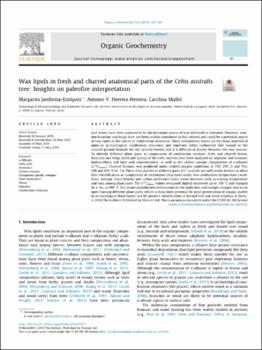Wax lipids in fresh and charred anatomical parts of the Celtis australis tree: Insights on paleofire interpretation
Date
2018Abstract
Leaf waxes have been assumed to be the dominant source of wax delivered to sediment. However, wooden branches and twigs have not been widely considered in this context and could be a potential source
of wax lipids in fire places or combustion structures. Black sedimentary layers are the main material of
open-air archaeological combustion structures and represent either carbonized fuel (wood) or the
charred ground beneath the fire (mainly leaves) and it is difficult to discern between the two sources.
To identify different plant parts as components of combustion residues, fresh and charred leaves,
branches and twigs (bark and xylem) of the Celtis australis tree were analyzed for aliphatic and aromatic
hydrocarbons and fatty acid concentrations, as well as the carbon isotopic composition of n-alkanes
(d13Calkane). Charred biomass was produced under limited oxygen conditions at 150, 250 (3 and 5 h),
350 and 450 C for 1 h. The n-alkyl profiles in different parts of C. australis are sufficiently distinct to allow
their identification as components of combustion structures under low combustion temperature conditions. Average chain lengths and carbon preference index ratios decrease with increasing temperature
and vary among plant parts. The d13Calkane values remained slightly unaltered up to 350 C and changed
by 3–4‰ at 450 C. Our results provide new information on the molecular and isotopic changes that occur
upon burning different plant parts, which in turn show potential for good preservation of organic matter
in archaeological black layers and for positive identification of burned leaf and wood residues in them.
2018 The Authors. Published by Elsevier Ltd. This is an open access article under the CC BY-NC-ND license





